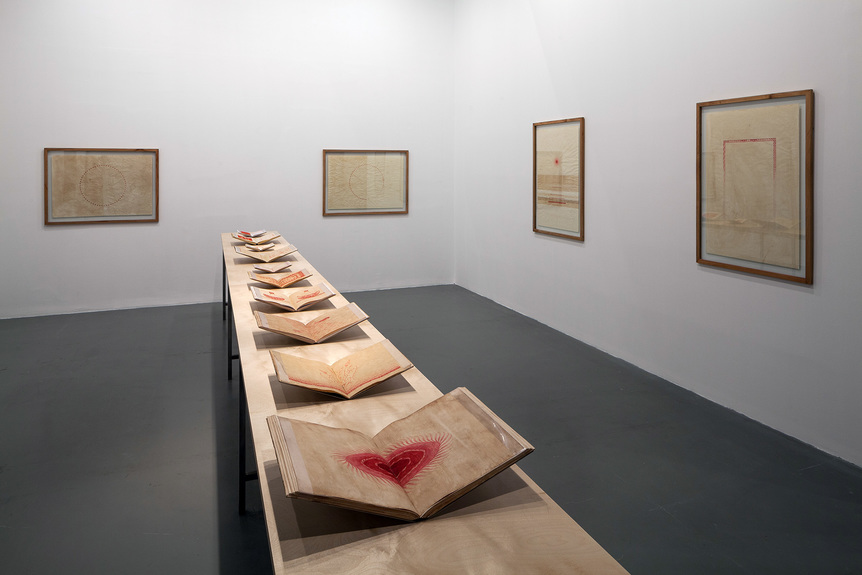-
From Current Issue
-
- Editor’s Letter Fire in the Heart
- Reviews I Gusti Ayu Kadek Murniasih
- Reviews 11th Seoul Mediacity Biennale: “One Escape at a Time”
- Dispatch Networked China
- One on One Monira Al Qadiri on Yukio Mishima
- Essays The rise of independent art spaces in pandemic-era Shanghai
- Features Tuan Andrew Nguyen
- Table of Contents
- Web Exclusives
- Archive
- Subscribe

R
E
V N
E
X
T
Installation view of AŞLI CAVUŞOĞLU’s The Place of Stone, 2018, fresco on 22 aerolam panels, 125 × 125 cm each, at “The Place of Stone,” New Museum, New York, 2018. Photo by Maris Hutchinson / EPW Studio. Courtesy New Museum.
In the introduction to his book Blue: The History of a Color (2000), early medieval historian Michel Pastoureau writes: “It is society that ‘makes’ color, defines it, gives it its meaning, constructs its codes and values, establishes its uses, and determines whether it is acceptable or not.” A cultural analysis of the uses of blue reveals far more than variegated shades and their associated symbolisms. Rather, the history of blue is simultaneously the history of mercantile trade, technology and empire.
Like Pastoureau, artist Aslı Çavuşoğlu’s interest in color is not merely aesthetic. Material concerns are rife in the practice of Çavuşoğlu, whose research-based works tackle questions of evidence as they pertain to objects. For The Stones Talk, produced for Istanbul’s Arter in 2013, the artist gathered 71 archaeological artifacts from Turkey that were deemed “incomplete” or “insignificant” by the Turkish Ministry of Culture and Tourism. Replicating and modifying these objects to build new “wholes” that were subsequently displayed in cases with labels, the artist interrogates the roles of institutions in forming and reifying historical and national narratives. In Red/Red (2015), Çavuşoğlu develops her dissection of the relation between material and nation-building vis-à-vis two instances of the color red: Armenian red, made from ground Armenian cochineal insects; and the more saturated Turkish red, used in the national flag, both of which she features in abstract drawings of botanical patterns and designs on notebooks and worn papers. As the Armenian ink fades through the pages of the books, the Turkish red becomes bolder, signifying the contentious political relationship between the two countries as well as the extinction of the cochineal insect, native to the Ararat Plain, which spans both Armenia and Turkey, as a result of industrialization in the 20th century.
Installation view of AŞLI CAVUŞOĞLU’s The Place of Stone, 2018, fresco on 22 aerolam panels, 125 × 125 cm each, at “The Place of Stone,” New Museum, New York, 2018. Photo by Maris Hutchinson / EPW Studio. Courtesy New Museum.
Installed in the New Museum’s glass-partitioned lobby gallery, Çavuşoğlu’s commissioned piece, The Place of Stone (2018), catalogs a similar investigation of the color blue. The work’s title is the English translation of Sar-i Sang, the site of lapis mines in Afghanistan. A fresco illustrated across 22 Aerolam panels—commonly used for insulation—The Place of Stone tracks, in several hues, the first stable blue color found in nature and its journey from the depths of mines across trade channels, and finally, its status as a “conflict mineral” today.
While scanning the panels from left to right does not necessarily offer a chronological narrative, there is a distinguishable pattern in the work. Abstract planes of blue in various shades comprise the leftmost compositions, while the ten panels in the center offer figurative representations of oceans and mercantile ships equipped with weapons, referencing the trade of lapis lazuli and its commodification in tile and jewelry products. The six panels to the right allude to contemporary uses of blue, including as a democratic symbol, evidenced by a concentric arrangement of stars evoking the European Union’s flag. In the last four segments, the artist depicts a series of images arranged in a loose grid: orbs painted in shades of blue, a flowering plant and mountains. Çavuşoğlu’s references range from Western abstract expressionism in the flat planes of blue, to Asian porcelain art and landscape painting. The range of colors, from ultramarine to azure and cerulean, suggests that the many uses of lapis lazuli has developed in tandem with the mineral’s widespread circulation; in doing so, the artist challenges the “purity” that the material has long evoked.
Çavuşoğlu’s history of lapis lazuli is neither complete nor conclusive; many of the images and symbols that she employs are inscrutable and obscure. This strategy, rather than obstructing or depreciating the experience of viewing the work, is in fact generative, allowing for encounters with the tactile, material and sensual aspects of color. In resisting a purely didactic form of representation, the artist has opened up a space in which material histories and aesthetic experiences can co-exist.
Aslı Çavuşoğlu’s “The Place of Stone” is on view at the New Museum, New York, until January 13, 2019.
To read more of ArtAsiaPacific’s articles, visit our Digital Library.














